Nissan hasn't dramatically altered the styling, powertrains, or features of its cars lately. Nevertheless, its Altima midsize sedan was the best-selling car model in the United States last month (March 2013), and is repeatedly among the top sellers. Whatever they're doing might not grab the attention of the public and the press, but it does effectively sell cars. Seeking the same success in the compact sedan segment, for 2013 Nissan has redesigned the Sentra along the lines of the Altima. Will they find what they seek?
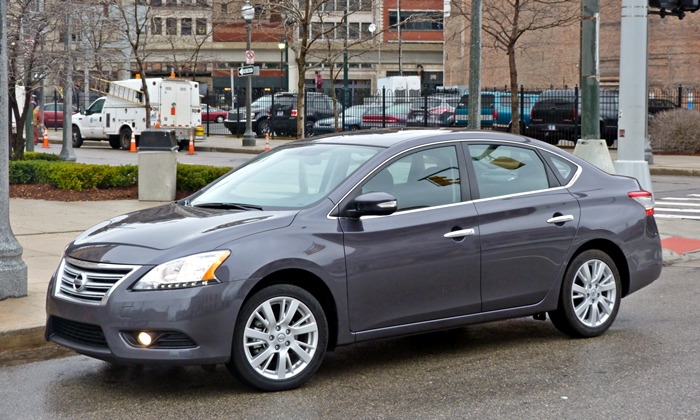
Elegant lines at home downtown. more Sentra photos
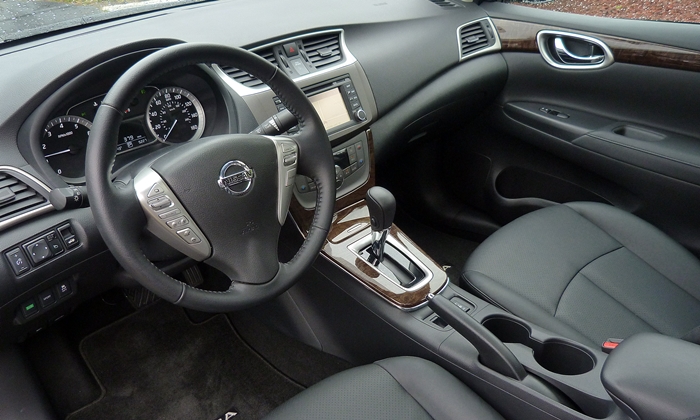
Appearance of traditional luxury.
| |
Compared to the Civic |
| Fuel economy |
 Better
Worse
Better
Worse
|
The Altima topped the rest of its segment in fuel economy, and the Sentra does the same, with EPA ratings of 30 mpg city, 39 highway. The Civic matches the highway number, but falls two short in the city.
The Sentra's trip computer substantiated these estimates, and then some. On the highway cruising at 65 it reported a two-way average of 40. In suburban driving it averaged 32. Driven on the same loop (which included warming up from a cold start) by the same driver, the Civic managed only 27. If both trip computers can be trusted (a fairly big if), this is quite a difference. When driven to maximize fuel economy, the gap was much narrower, 35 vs. 36. In general, though, the Sentra seemed to go another two or three miles on each gallon.
Ironically, the main damper on the Sentra's win comes from within the family. Though much larger and considerably more powerful (182 vs. 130 horsepower), the Altima is nearly as fuel efficient, with EPA ratings of 27/38. In Nissan's defense, no auto maker can seem to get much better fuel economy out of a compact (or even subcompact) sedan than a midsize.
| Materials & workmanship |
 Better
Worse
Better
Worse
|
Cars have been getting nicer and nicer inside, and the Sentra doesn't buck the trend, at least not in the tested top-of-the-line SL. At first glance, the interior ambiance is "compact Lexus." Very conservative, with perhaps a bit much shiny plasti-wood trim, but decidedly more upscale than the class norm. At second glance, the materials and detailing support the initial impression (in sharp contrast to those inside the subcompact Versa). The door panels are cushily upholstered. The matte finish of the soft-touch upper instrument panel would have been welcome in Toyota's flagship sedan. One nit: the padded upholstery on the door panel is ungrained, but the hard plastic that abuts it on the instrument panel has a grained texture.
The Honda Civic's interior was hastily upgraded for 2013. It doesn't play the luxury card as hard, but the new materials aren't far off the Sentra's. Choosing between the two interiors will come down to personal taste, as they differ greatly in appearance and ambiance.
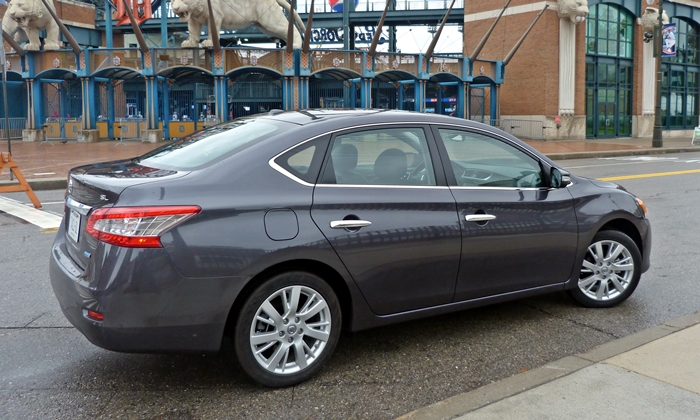
SL's 17-inch wheels and wavy character line reduce the visual bulk of the tall body side.
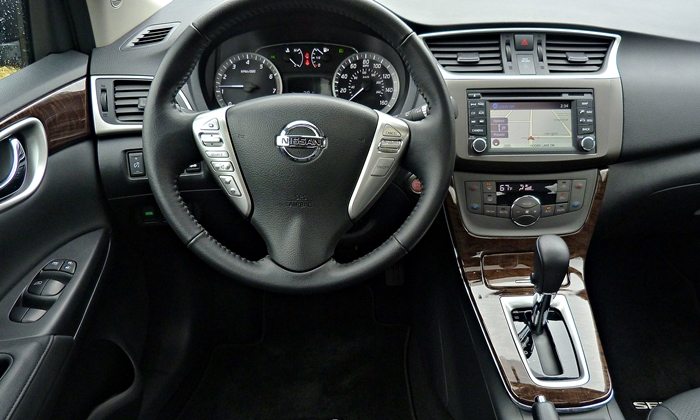
Classy, traditional gauges and logical controls.
| Quietness |
 Better
Worse
Better
Worse
|
When cruising (we'll get to this caveat later), the Sentra is much quieter inside than the Civic, especially on concrete. Some other cars in the segment might be as quiet, but none are significantly quieter.
| Ride smoothness |
 Better
Worse
Better
Worse
|
The Sentra also rides smoothly over small-to-medium road imperfections. (Some large bumps and dips expose the limits of the front suspension.) The Civic's firmer suspension doesn't filter out nearly as much of the small stuff. Quiet + smooth = relaxing commute.
| Price or payments |
 Better
Worse
Better
Worse
|
The tested Nissan Sentra, an SL with Navigation, Premium (Bose Audio + sunroof), and Leather Packages, lists for $23,430. Domestic brand competitors top out about $4,000 higher (though with additional equipment). A similarly equipped Honda Civic lists for $1,125 more ($24,555). Adjust for feature differences (key you can leave in your pocket, auto-dimming mirror, fog lights) and the Nissan's advantage widens to about $1,700. Compared to a Hyundai Elantra Limited with nav, the Sentra is $890 less before adjusting for feature differences, and about $100 less afterwards. (The Hyundai has some features not offered on the Sentra: power driver seat, heated rear seat, and universal garage door opener.) Compared to a Ford Focus Titanium with nav, the Sentra is $2,255 less before adjusting for feature differences, but only about $275 less afterwards (the top-of-the-line Ford includes even more features not available on the Sentra SL, including remote start, rear obstacle detection, and interior ambient lighting).
Bottom line: the Sentra is a good value if you only want the features it offers, but about even with the Elantra and Focus if you also want those it doesn't offer.
| |
Compared to the Civic |
| Powertrain performance |
 Better
Worse
Better
Worse
|
Aided by a continuously variable transmission (CVT), the 130-horsepower 1.8-liter four-cylinder engine motivates the 2,800-pound Sentra well enough. But the CVT gets the most out of the Sentra's engine by revving it to a high rpm and holding it there. The way the CVT varies engine speed it has the feel of a slipping transmission. Compounding this misbehavior, and then some: when revved the engine produces an unseemly racket entirely out of character with the Sentra's otherwise premium persona. The CVT works reasonably well with the larger four cylinder engine in the Altima, and surprisingly well with Nissan's V6. But paired with the smaller engines it could be Exhibit A in the case against CVTs. This said, if Nissan could reduce and tune the sound made by the engine, this in itself would help a lot. Or just put the 2.5 in the Sentra, if it will fit. Judging from the Altima's EPA ratings, the fuel economy hit wouldn't be significant.
| Front seat support & comfort |
 Better
Worse
Better
Worse
|
The Nissan Sentra offers a smooth, quiet ride and about as much passenger (and cargo) room as you'll find in a compact sedan. Open the door, and the SL's leather-trimmed interior appears luxurious. Sit down, though, and the illusion crumbles. Unlike those in the Altima, the Sentra's flat, firm seats provide little in the way of comfort or support. A tilt adjustment for the driver seat would help, but one is not offered. The Civic's seats aren't much cushier, but their shape provides better support. For the best seats in the segment, check out the Chevrolet Cruze and Ford Focus.
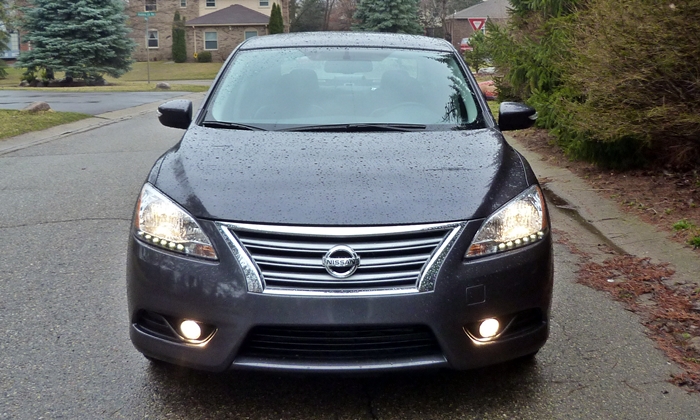
Tall with a big chrome grille.
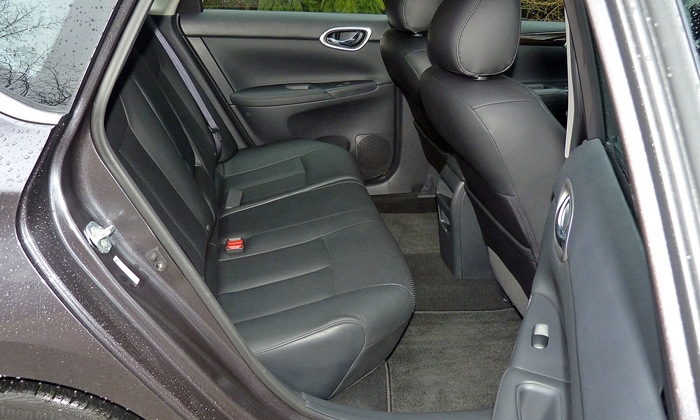
Plenty of legroom in the back. The cushion is a little low, but this is common even in larger cars.
| Driving position & visibility |
 Better
Worse
Better
Worse
|
The Sentra's driving position could also be better. Even with the driver seat in its lowest position you sit too high. And yet forward visibility is only good rather than great because the instrument panel is taller than most. Rearward visibility is limited (if no more than in many cars these days) by a high trunk. The steering wheel telescopes, but in my case not far enough. The Civic's driving position feels sportier and more comfortable and provides better forward visibility despite that car's massive bi-level instrument panel and steeply raked windshield.
| Handling |
 Better
Worse
Better
Worse
|
On the highway, the Sentra is easily knocked off course by crosswinds. In suburban driving, though, the Sentra handles safely and predictably, with better composure than I expected given the fairly soft suspension. There's some lean in hard turns, but "soggy" or "clumsy" never entered my mind. Compared to the Civic, the Sentra felt like it was going through the curves of my test route more slowly, but a glance at the speedometer found that it was actually going through them more quickly. Credit/blame the Nissan's smooth, quiet ride and uncommunicative steering. While you can drive the Sentra fairly quickly, you won't have any fun doing so.
| Exterior styling |
 Better
Worse
Better
Worse
|
On the subject of compact cars, legendary GM designer Bill Mitchell once quipped, "It's hard to tailor a dwarf." While it's certainly possible to design an attractive small car, if you simply shrink the design off a larger one the end result tends to suffer from dumpy proportions. Even the 195-inch-long Infiniti M appears stout when not fitted with the optional 20-inch wheels. The 192-inch-long Altima barely manages to pull off M-inspired (if simplified and leaner) curves. It's no beauty. The Sentra, with lines much like the Altima's but with nearly ten inches less length AND an inch more height, is Mitchell's dwarf. From some angles it appears elegant, from others it looks like a portly kid dressing up in daddy's clothes (if not quite the parody of a large luxury sedan that the narrow, 175-inch-long Versa is).
The 2013 Sentra's best angle is directly from the side. A large chrome grille reeking of less-than-tasteful upward aspiration dominates the front view. With an unusually rectangular shape and muffin top tail lamps, the Sentra's derriere looks--is there a delicate way to put this?--graceless. There are uglier cars. But there are also much prettier ones.
So, we've got some pros, and we've got some cons. But too many cars try to be everything to everyone, and end up with little in the way of an identity. It's okay to not appeal to some or even most buyers if you strongly appeal to a large enough group of other buyers. The Sentra comes close enough to successfully executing a focused "traditional luxury" strategy that, with a Civic and a Sonata also in my driveway the week I had it, it was the car I chose to drive when I wanted to relax. Eliminate untoward engine noise and add some Altima-like seats, and the Sentra would strongly appeal to people who want a luxurious compact sedan. Put another way, make these changes and they'll have built a better Toyota just as Toyota, concerned about its demographics, heads off in a sportier direction.
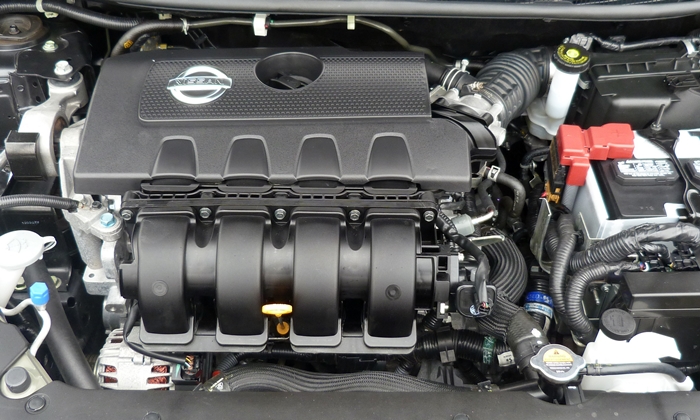
Efficient and adequately powerful, but unpleasantly noisy.
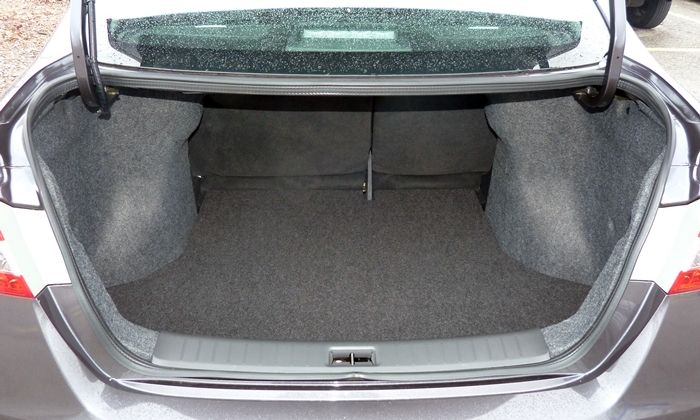
Among the most spacious trunks in the segment (the others are in the Cruze and Jetta).
See more 2013 Nissan Sentra photos
Nissan provided an insured car with a tank of gas for a week.











